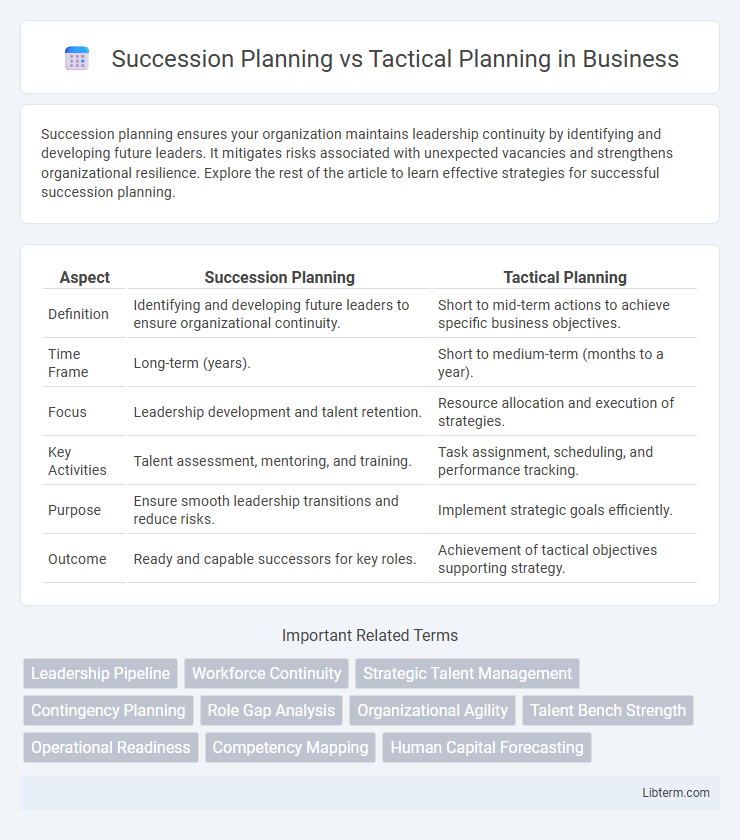Succession planning ensures your organization maintains leadership continuity by identifying and developing future leaders. It mitigates risks associated with unexpected vacancies and strengthens organizational resilience. Explore the rest of the article to learn effective strategies for successful succession planning.
Table of Comparison
| Aspect | Succession Planning | Tactical Planning |
|---|---|---|
| Definition | Identifying and developing future leaders to ensure organizational continuity. | Short to mid-term actions to achieve specific business objectives. |
| Time Frame | Long-term (years). | Short to medium-term (months to a year). |
| Focus | Leadership development and talent retention. | Resource allocation and execution of strategies. |
| Key Activities | Talent assessment, mentoring, and training. | Task assignment, scheduling, and performance tracking. |
| Purpose | Ensure smooth leadership transitions and reduce risks. | Implement strategic goals efficiently. |
| Outcome | Ready and capable successors for key roles. | Achievement of tactical objectives supporting strategy. |
Introduction to Succession Planning and Tactical Planning
Succession planning is a strategic process focused on identifying and developing internal talent to fill key leadership roles, ensuring business continuity and long-term organizational stability. Tactical planning involves creating short-term, action-oriented plans that support the execution of broader strategic goals by addressing immediate operational needs. Both planning approaches are essential for comprehensive organizational management, balancing future leadership readiness with day-to-day operational effectiveness.
Defining Succession Planning
Succession planning involves systematically identifying and developing internal talent to fill key leadership positions, ensuring business continuity and long-term organizational success. It focuses on preparing high-potential employees through mentorship, training, and career development to seamlessly transition into critical roles. Effective succession planning minimizes risks associated with unexpected vacancies and aligns leadership growth with strategic objectives.
Defining Tactical Planning
Tactical planning involves developing specific, short-term actions and resource allocations to achieve the strategic objectives set by an organization within a defined timeframe. It translates high-level goals into detailed operational plans, focusing on departments or units to drive efficiency and effectiveness. Unlike succession planning, which centers on leadership development and talent continuity, tactical planning emphasizes immediate task execution and performance optimization.
Key Objectives of Succession Planning
Succession planning focuses on identifying and developing internal talent to fill key leadership roles, ensuring organizational continuity and minimizing disruptions during transitions. Key objectives include maintaining a robust talent pipeline, promoting employee retention by providing clear career paths, and aligning leadership development with long-term business strategies. This strategic approach contrasts with tactical planning, which emphasizes short-term, operational goals and immediate resource allocation.
Core Aims of Tactical Planning
Tactical planning centers on translating strategic goals into actionable short-term objectives that optimize resource allocation, enhance operational efficiency, and achieve specific performance targets within defined timeframes. It prioritizes addressing immediate organizational needs, managing team workflows, and adapting quickly to market or environmental changes. This approach ensures that daily activities align closely with broader strategic aims while maintaining flexibility to respond to tactical challenges.
Differences Between Succession and Tactical Planning
Succession planning focuses on identifying and developing future leaders within an organization to ensure long-term leadership continuity, while tactical planning concentrates on short-term actions and resource allocation to achieve specific business objectives. Succession planning is strategic and future-oriented, emphasizing talent development and risk management in leadership roles, whereas tactical planning is operational and immediate, centered on executing plans that support broader strategic goals. The key difference lies in their time horizon and purpose: succession planning secures leadership pipeline readiness over years, while tactical planning manages daily or quarterly activities to meet current targets.
Benefits of Succession Planning for Organizations
Succession planning secures long-term organizational stability by identifying and developing internal talent to fill key leadership roles, reducing disruptions caused by unexpected departures. This strategic approach enhances employee retention and morale by creating clear career advancement opportunities, fostering loyalty and motivation. Organizations benefit from reduced recruitment costs and faster leadership transitions, ensuring continuity and sustained competitive advantage.
Advantages of Tactical Planning in Business Operations
Tactical planning enhances business operations by enabling clear allocation of resources and establishing specific short-term goals that align with overall strategic objectives. It provides agility in decision-making, allowing businesses to respond swiftly to market changes and operational challenges. This focused approach improves efficiency, boosts team coordination, and ensures measurable progress toward immediate business priorities.
When to Use Succession Planning vs Tactical Planning
Succession planning is essential when preparing for future leadership transitions and ensuring organizational stability during key personnel changes. Tactical planning should be used when addressing short-term objectives, resource allocation, and immediate operational challenges. Understanding the timing and purpose of each plan helps align strategic goals with workforce capabilities and business needs.
Integrating Succession and Tactical Planning for Business Success
Integrating succession planning with tactical planning ensures a seamless transition of leadership while maintaining operational efficiency, fostering sustained business growth. Companies that align talent pipelines with short-term objectives enhance their agility and resilience in dynamic markets. Strategic synchronization between these plans mitigates risks associated with leadership gaps and accelerates goal achievement.
Succession Planning Infographic

 libterm.com
libterm.com